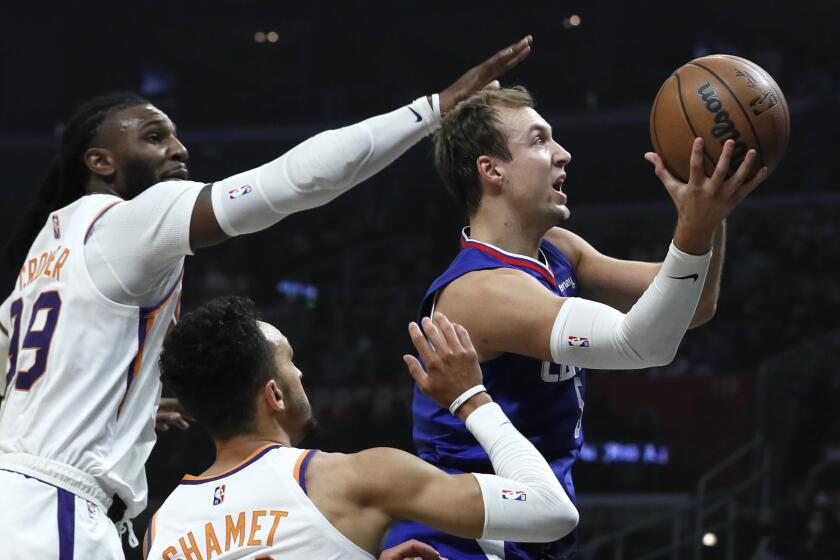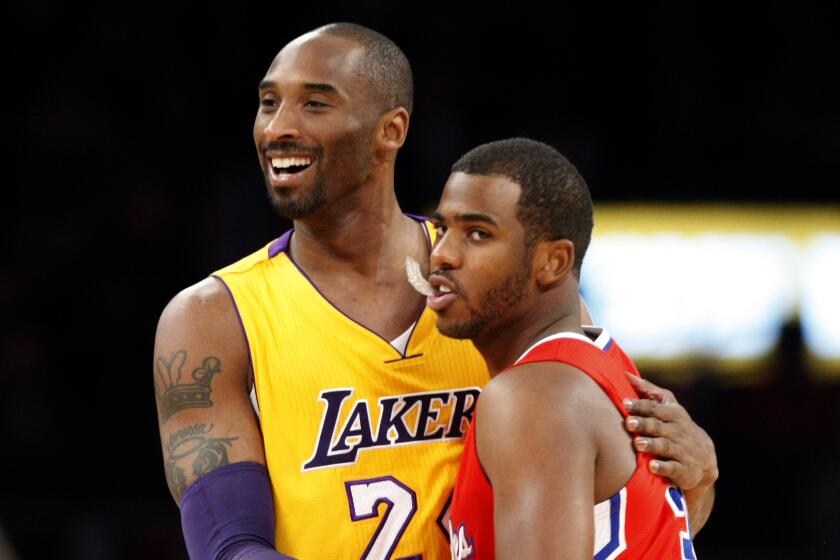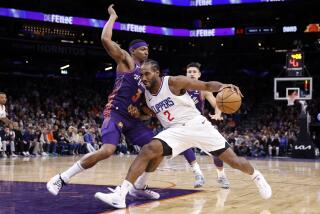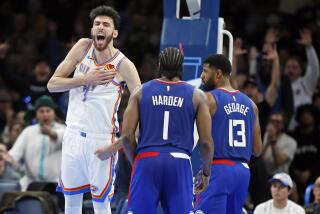Clippers’ struggles in loss to Jazz go beyond injuries to star players
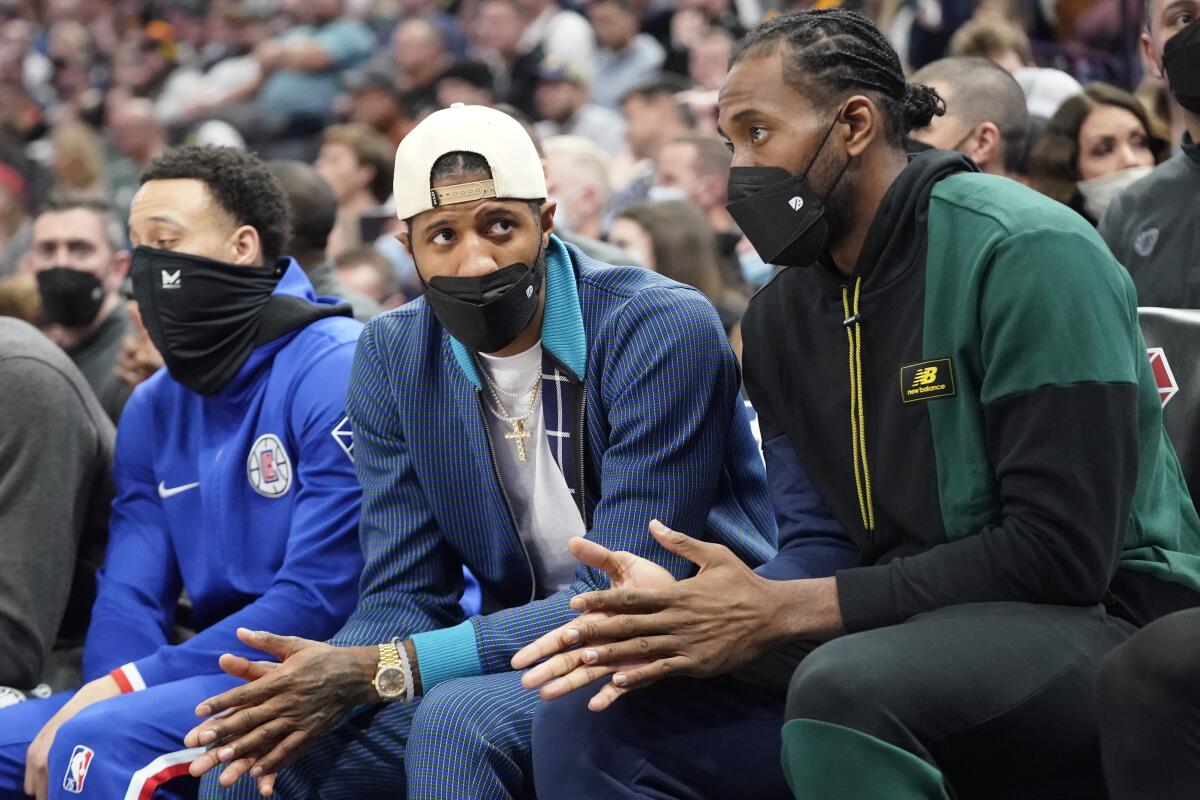
- Share via
SALT LAKE CITY — Wednesday for the Clippers began with a grimace.
Running around imaginary screens inside Vivint Arena before the team’s morning shootaround, as Kawhi Leonard casually dribbled on the court’s other end while shooting with his left hand in a down-filled parka, Nicolas Batum tested his sprained ankle. By the expressions on his face, it quickly became apparent the Clippers would face Utah hours later without the glue of their bench unit. Leading scorer Paul George, with a sprained elbow, was later ruled out for a fourth consecutive game, as well.
And so the Clippers were back where they were last time they visited Utah, six months ago — short-handed underdogs facing one of the league’s most formidable opponents.
That victory, in Game 5 of a second-round series eventually won by the Clippers in six games, will go down among the most important postseason games in franchise history. Wednesday’s 124-103 loss, in contrast, will likely quickly be forgotten.
The Clippers take advantage of the Phoenix Suns’ shooting woes to overcome their own accuracy issues to pull off a 111-95 victory.
But as the Clippers continue to search for who they are this season with their emotional win in Utah now six months in the rear-view mirror, this night underscored that progress — and what has hindered it, beyond simply attrition.
“For 32 minutes we played some pretty good basketball,” coach Tyronn Lue said. “Unfortunately, the game is 48 minutes. We did some good things. Undermanned and missing a lot of scoring on the floor, but I thought our guys played hard and competed, we just didn’t have enough offensively.”
The NBA’s most anemic team in transition by at least one metric, the Clippers needed 35 minutes to score their first fast-break point, their run-outs prevented largely by Utah’s shot-making — 52% overall, and 40% from three. Such transition struggles have left them unable to capitalize on opponents’ mistakes all season, and again Wednesday, it took them 39 minutes to turn a Utah’s seventh turnover into points.
The Clippers’ four-game winning streak ended after being outscored 18-2 in points off turnovers, and Donovan Mitchell (27 points) was one of four Jazz players to finish with at least 20 points, the kind of balanced scoring that has led Utah to lose just once since Thanksgiving.
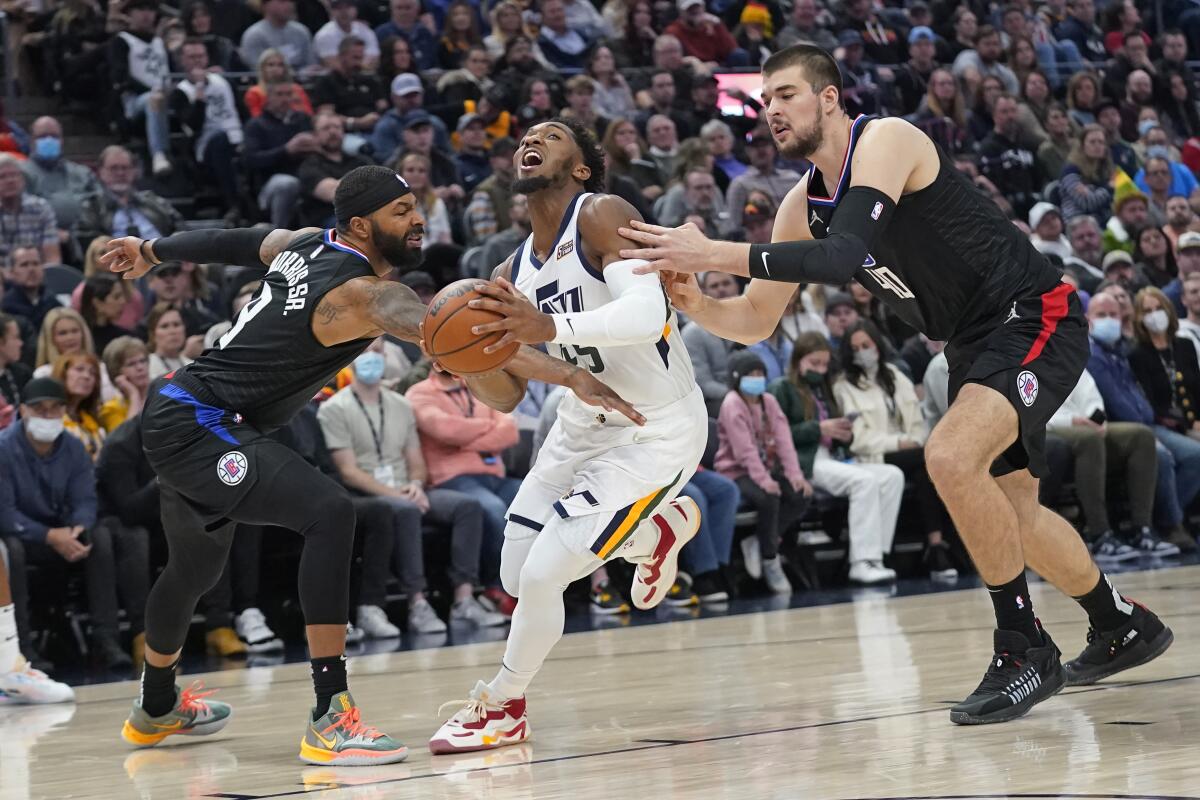
But the final score belied the scrappiness — and early jump-shooting — that felt like a callback to June, even though the Clippers, down Leonard, Batum and George could not turn to the small-ball lineups that spurred their playoff turnaround. That they were within seven points in the fourth quarter centered on the production of a guard who wasn’t even on the roster last season.
In the night’s most promising sign, reserve guard Eric Bledsoe provided a steadying offensive influence with 21 points, equaling his most since Nov. 14. Unsteady with his jump shot throughout the season’s first month, Bledsoe made eight of his 10 shots and four of his five three-pointers — as many as he’d made in his previous six games combined — while adding eight assists. And he did it while the Clippers (16-13) were able to eke out only 25 minutes from starting guard Reggie Jackson (15 points, nine assists) as he continued to labor one game after taking a knee to the thigh.
Moving Bledsoe to the bench seven games ago has not cured all of the Clippers’ woes, but it’s fixed the problem of who will be the second unit’s ballhandler, and he has an assist-to-turnover ratio of four to one since the switch.
“I just thought his pace was really good,” Lue said of Bledsoe. “His pace has been really good for us all season but tonight he found an extra gear.”

The Clippers were also without center Serge Ibaka. Though the team initially attributed his absence Tuesday to “personal reasons,” a person with knowledge of Ibaka’s status said that a person close to Ibaka had tested positive for COVID-19 and that he remained home as a precaution. Wednesday morning Lue said that Ibaka had returned a negative test before tipoff of Monday’s win against Phoenix, and a second the following day before the team’s charter departed for Utah, but felt he should remain home as COVID cases rise throughout the NBA.
Their absences portended trouble. Yet the short-handed Clippers not only survived but thrived for a half. After Marcus Morris Sr. and Luke Kennard went to the bench in the first quarter after combining to score 21 of the team’s first 25 points, Bledsoe and Isaiah Hartenstein picked up where they left off, combining to make 10 of their 12 shots in the first half for 22 total points.
Despite making just one shot within four feet of the rim in the first 24 minutes, and behind held without a three-pointer for more than eight minutes in the second quarter — this after starting seven of 11 from deep — the Clippers were within six of Utah at halftime.
An oral history of why the Lakers’ deal to land Chris Paul was denied by the NBA in December 2011, and a deal to send the All-Star point guard to the Clippers was approved.
But not even halfway through the third quarter, the bill of Utah’s two-day advantage in rest and healthy bodies came due, with the Clippers outscored by six in the quarter. After their hot start Morris (24 points) and Kennard (10 points) made one of their next 12 shots. The Clippers fell to 1-12 when trailing entering the fourth quarter.
Utah knows who it is, after several seasons of remarkable roster continuity. The Clippers are still finding their own identity, a process hampered by injuries, Morris said.
More to Read
Go beyond the scoreboard
Get the latest on L.A.'s teams in the daily Sports Report newsletter.
You may occasionally receive promotional content from the Los Angeles Times.

